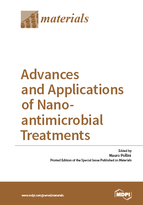Advances and Applications of Nano-antimicrobial Treatments
A special issue of Materials (ISSN 1996-1944). This special issue belongs to the section "Biomaterials".
Deadline for manuscript submissions: closed (31 March 2016) | Viewed by 64172
Special Issue Editors
Interests: wound healing; bioengineering; tissue engineering; silk proteins; infections; silver
Special Issues, Collections and Topics in MDPI journals
Interests: tissue engineering; bioengineering; antibacterial treatments; silver; fibroin; sericin; nanocoatings
Special Issues, Collections and Topics in MDPI journals
Interests: macromolecular hydrogels; scaffolds for tissue engineering and regenerative medicine; wound dressings; surface and antibacterial treatments
Special Issue Information
Dear Colleagues,
Nowadays, great concerns are associated with the resistance demonstrated by many microorganisms towards the conventional antibiotic therapies. The failure of traditional antimicrobials, and the increasing healthcare costs, have encouraged scientific research and the development of novel antimicrobial agents. Particularly, there is a great deal of interest in nanotechnologies and in antibacterial products obtained through the incorporation of antibacterial agents or the deposition of antibacterial coatings for prevention of biofilm-associated infections.
The main focus of the forthcoming Special Issue is, therefore, to present the most recent efforts in scientific research in the development of advanced antimicrobial materials, with special attention to nature-inspired antimicrobial agents and antimicrobials nanomaterials and nanocoatings. For this purpose, we intend to collect original research articles and reviews on the synthesis and characterization of antimicrobial agents, as well as on the development of antimicrobial products for different applications.
Dr. Mauro Pollini
Prof. Dr. Alessandro Sannino
Dr. Federica Paladini
Guest Editor
Manuscript Submission Information
Manuscripts should be submitted online at www.mdpi.com by registering and logging in to this website. Once you are registered, click here to go to the submission form. Manuscripts can be submitted until the deadline. All submissions that pass pre-check are peer-reviewed. Accepted papers will be published continuously in the journal (as soon as accepted) and will be listed together on the special issue website. Research articles, review articles as well as short communications are invited. For planned papers, a title and short abstract (about 100 words) can be sent to the Editorial Office for announcement on this website.
Submitted manuscripts should not have been published previously, nor be under consideration for publication elsewhere (except conference proceedings papers). All manuscripts are thoroughly refereed through a single-blind peer-review process. A guide for authors and other relevant information for submission of manuscripts is available on the Instructions for Authors page. Materials is an international peer-reviewed open access semimonthly journal published by MDPI.
Please visit the Instructions for Authors page before submitting a manuscript. The Article Processing Charge (APC) for publication in this open access journal is 2600 CHF (Swiss Francs). Submitted papers should be well formatted and use good English. Authors may use MDPI's English editing service prior to publication or during author revisions.
Keywords
- infections
- antimicrobial
- nanomaterials
- biofilm
- antibiotic-resistance









